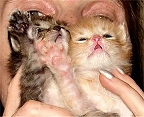For many people, the pleasure of seeing these young creatures is mixed with a sense of protectiveness—of wanting to help them survive. But spotting a baby animal by himself doesn't necessarily mean he's an orphan. Many wildlife parents leave their young alone during the day, sometimes for long periods. The parent is usually nearby and quite conscious of her young. Also, keep in mind that despite their small size, many young animals are actually independent enough to fend for themselves.
How can you tell if an animal needs your help or should be left alone? Here are some general signs to look for:
- A wild animal presented to you by a cat or dog
- Bleeding
- An apparent or obvious broken limb
- A featherless or nearly featherless bird (nestling) on the ground
- Shivering
- Evidence of a dead parent nearby
If a wild animal exhibits any of the above signs, you should immediately call one of the following local resources for assistance. You will find listings for most of these in your telephone directory.
- Wildlife rehabilitator
- Animal shelter
- Animal control agency
- Wildlife/exotic animals veterinarian
- Nature center
- Wild bird store
- State wildlife agency
Once you've contacted the right person, describe the animal and his physical condition as accurately as possible. Unless directed otherwise, here's how you can make an animal more comfortable for transport or while you're waiting for help to arrive:
- Punch holes, from the inside out, into a cardboard box or other container. A paper bag may be suitable for most songbirds.
- Line the box with an old T-shirt or other soft cloth.
- Put on gloves.
- Use a towel or pillowcase to cover the animal, then scoop him up gently and place him in the container.
- Do not give the animal food or water. He could choke, develop digestive problems, or drown. Many injured animals are in shock, and eating or drinking can make it worse.
- Place the container in a warm, dark, quiet place—away from pets, children, and noise—until you can transport the animal.
- Transport the animal as soon as possible. While in the car, keep the carrier out of the sun and away from direct air conditioning or heat. Keep the car radio off and talking to a minimum.
- Never handle an adult animal without first consulting with a wildlife professional. Even small animals can injure you.
Remember, many animals who appear to be orphaned are not. Unless one or more of the signs mentioned above is present, do not attempt to rescue animals in any of the following circumstances:
- A fawn (baby deer) who is curled up in the grass and appears approachable. His mother is most likely out of sight, but nearby and watching you.
- A bird who is fully feathered on his body with evidence of tail feathers, hopping on the ground, but unable to fly. This is a fledgling (adolescent bird), and his parents are probably nearby.
- A rabbit who is four inches long with open eyes and erect ears. She is independent from her mother and able to fend for herself.
- An opossum who is nine to ten inches or longer, not including the tail. He is independent.
- A squirrel who is nearly full sized, has a full and fluffy tail, and is able to run, jump, and climb. She is independent.

